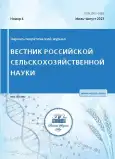Genetic aspects in working with the kholmogory cattle breed in the arkhangelsk region
- Authors: Prozherin V.P1, Selkova I.V1
-
Affiliations:
- Federal Research Center for Comprehensive Study of the Arctic named after Academician N.P. Laverov
- Issue: No 4 (2023)
- Pages: 93-100
- Section: Articles
- URL: https://journals.rcsi.science/2500-2082/article/view/141518
- DOI: https://doi.org/10.31857/2500-2082/2023/4/93-100
- EDN: https://elibrary.ru/DNSNIB
- ID: 141518
Cite item
Full Text
Abstract
About the authors
V. P Prozherin
Federal Research Center for Comprehensive Study of the Arctic named after Academician N.P. Laverov
Email: PVP29@mail.ru
20, Nikolsky ave., Arkhangelsk, 163020
I. V Selkova
Federal Research Center for Comprehensive Study of the Arctic named after Academician N.P. Laverov
Email: selkova2458@bk.ru
20, Nikolsky ave., Arkhangelsk, 163020
References
- Винокуров А.Ю. Использование групп крови крупного рогатого скота при характеристике популяционно-генетических процессов. Молодые ученые - агропромышленному комплексу. Ульяновск. С. 91-94.
- Деева В.С., Сухова Н.О. Группы крови крупного рогатого скота и их селекционное значение. РАСХН. Сиб. отд-ние. СибНИПТИЖ. Новосибирск, 2002. 172 с.
- Ильина А.В., Муштукова Ю.В., Хуртина О.А. Генетическая оценка состояния популяционного генофонда крупного рогатого скота ярославской породы в ОАО "Михайловское" Ярославского района // Вестник АПК Верхневолжья. 2014. №3 (27). С. 39-42.
- Калязина Т.В. Использование генной технологии для характеристики аллелофонда черно-пестрого скота. Дис. к.б.н. 06.02.07 п. Быково Моск. обл. М., 2012. 113 с.
- Коновалов А.В., Ильина А.В., Хуртина О.А., Зверева Е.А. Иммуногенетические маркеры популяции крупного рогатого скота ярославской породы. Интенсивные технологии производства продукции животноводства: Сборник статей Межд. науч.-практ. конф. Пенза, С. 28-32.
- Коновалов А.В., Косяченко Н.М., Ильина А.В. Информационная база данных в оценке иммуногенетических и молекулярно-генетических характеристик ярославской породы крупного рогатого скота // Современные наукоемкие технологии. Региональное приложение. 2015. № 3 (43). С. 153-156.
- Марзанова Л.К., Попов Н.А. Контроль за генетической изменчивостью в стадах молочных пород // Молочное и мясное скотоводство. 2018. №8. С. 16-18. doi: 10.25632/MMS.2018.75.35.004.
- Меркурьева Е.К. Генетические основы селекции в скотоводстве. Учебные пособия для факультетов повышения квалификации руководящих кадров колхозов и совхозов, и специалистов сельского хозяйства. М., 1977. 189 с.
- Новиков А.А., Хрунова А.И., Рыжова Н.Г. Влияние голштинизации скота холмогорской породы на частоты встречаемости аллелей ЕАВ-локуса групп крови. Сборник статей X Международной научно-практической конференции, посвященной 180-летию со дня рождения Н.В. Верещагина. Тверь, С. 136-139.
- Прожерин В.П., Ялуга В.Л., Рухлова Т.А., Кувакина И.В., Хуснутдинова Е.Д. Система селекционно-племенной работы с холмогорской породой крупного рогатого скота в Архангельской области на период 2014-2019. М-во агропром. комплекса и торговли Арханг. обл., ФГБНУ "Архангельский НИИСХ", Центр информ. обеспечения по холмогор. породе крупного рогатого скота. Архангельск, 2014. 122 с.
- Семенюк О.В. Молекулярно-генетические аспекты оценки и прогнозирования молочной продуктивности крупного рогатого скота. Дис. к.б.н: 03.00.23. Ставрополь, 2006. 147 с.
- Сороковой П.Ф. Методические рекомендации по исследованию и использованию групп крови в селекции крупного рогатого скота. Дубровицы: Издательство ВИЖ, 1974. 40 с.
- Nei, M. The theory of genetic distance and evolution of human races. // Jap Human Genetics. 1978. V. 23. P. 341-369. doi: 10.1007/BF01908190.
- Rendel J., Gahne B. Serological and biochemical methods for diagnosis of zygosity in cattle twins // Proc. EAAP meeting in Stockholm. 1960. № 8. P. 162-190.
Supplementary files










